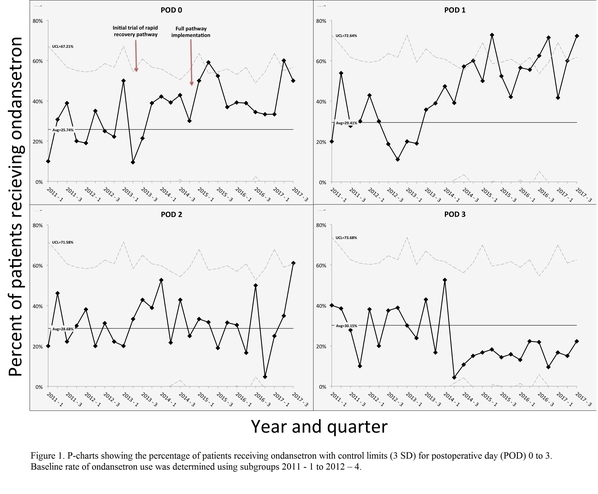NM-372
Unintended Consequences: Rising ondansetron use following the implementation of a rapid recovery protocol for pediatric spine fusion
O'Neill D, Tan J, Flynn J, Sankar W, Muhly T
Children's Hospital of Philadelphia, Philadelphia, PA, USA
Introduction: Using quality improvement (QI) methodology, we implemented a rapid recovery pathway (RRP) focusing on multimodal pain management and early mobilization strategies in an effort to improve the recovery of patients undergoing posterior spine fusion for adolescent idiopathic scoliosis (AIS)1. Post-operative nausea and vomiting (PONV), was not examined in our initial analysis. While the RRP improved pain management outcomes and reduced length of stay, we became concerned that this surgical population was having increased post-operative nausea and emesis. We have analyzed the temporal use of ondansetron to determine if PONV is a balancing metric we failed to recognize.
Methods: Using the real-time data collection tool developed for our initial QI project (QlikView, Radnor, PA), we extracted data on ondansetron use by postoperative day (POD). Ondansetron administration was considered a binary outcome (yes/no) and patients were grouped in quarterly intervals from January 2011 through August 2017. The percentage of patients receiving ondansetron by POD was graphically displayed using a P-chart (SPC for Microsoft Excel) and baseline ondansetron use was set using pre-RRP implementation data (1/1/11 thru 12/31/12).
Results: We observed a temporal increase in administration of ondansetron on POD 0 and 1 with initiation of a formalized recovery pathway (Fig 1). The percentage of patients using ondansetron was 26%, 29%, 29% and 30% for the historical control compared to 43%, 59%, 32%, and 16% percent following RRP implementation on POD 0, 1, 2, and 3, respectively. Special cause variation was confirmed with 2 and 4 points above the upper confidence interval for POD 0 and 1 following pathway implementation.
Discussion/Conclusion: Implementation of QI initiatives can have profound impacts on patient outcomes. Vigilance and continued review of the larger clinical impact is vital to ensure that improvements in one area do not precipitate adverse outcomes in another. We have identified that more patients require ondansetron on POD 0 and 1, suggesting that our patients may experience more POV and/or PONV when managed with the RRP. Future interventions will include revision of our data to include assessment of postoperative emesis rate, intraoperative PONV prophylaxis administration, patient reported nausea symptoms and introduction of a preoperative anti-emetic agent designed to improve our nausea rates. By systematically refining our recovery pathway we hope to further improve the experience and outcomes for our spine fusion patients.
References:
1. Muhly WT, Sankar WN, Ryan K, et al. Rapid Recovery Pathway After Spinal Fusion for Idiopathic Scoliosis. Pediatrics. 2016;137(4).
Top












